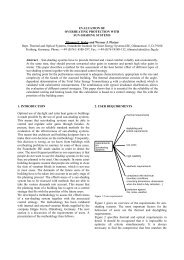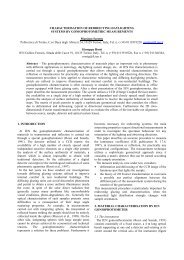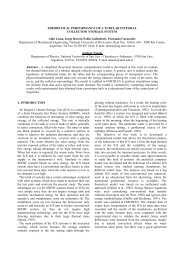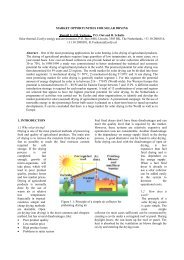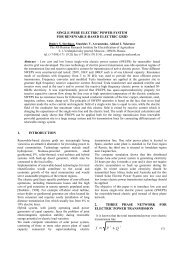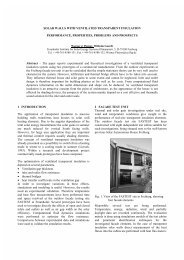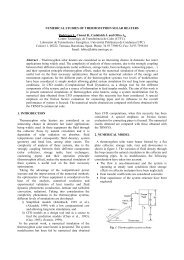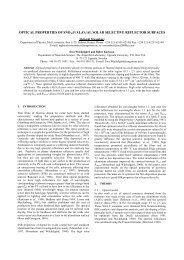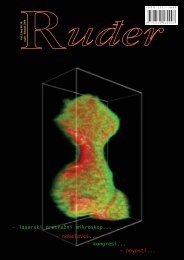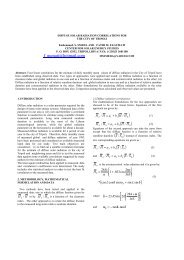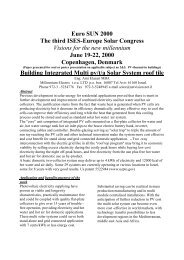SOLAR CITIES: UTOPIA OR POSSIBLE REALITY? Federico Butera ...
SOLAR CITIES: UTOPIA OR POSSIBLE REALITY? Federico Butera ...
SOLAR CITIES: UTOPIA OR POSSIBLE REALITY? Federico Butera ...
Create successful ePaper yourself
Turn your PDF publications into a flip-book with our unique Google optimized e-Paper software.
<strong>SOLAR</strong> <strong>CITIES</strong>: <strong>UTOPIA</strong> <strong>OR</strong> <strong>POSSIBLE</strong> <strong>REALITY</strong>?<strong>Federico</strong> <strong>Butera</strong>Di.Tec, Politecnico di Milano, via Durando 38/A, 20158 Milano, Italy, tel. +39-02 2399 7257, fax +39-02 2399 7255,e-mail butera@tin.itAbstract — Are solar cities of XXI century another utopia? If not, how should be a solar city? The papertries to give an answer to both questions, starting from an historical background.The degree of energy self-sufficiency of a city is discussed and its possible ways of evolution –in terms ofstructure, techniques and technologies, organisation, etc.– towards the solar city. The paper explores thepossible technical and technological options suitable to a solar city in the near term, supported withexamples, including architecture and town planning.An insight is also given into the social and cultural dimension of the transformation/mutation processleading to the new organism “solar city”: a dimension that is recognised as more critical than thetechnological one. The importance of concerted actions among the many actors involved –often withconflicting interests– is also discussed, and the importance of appropriate political actions, as well as therole of information. Within this context special attention is focused on the role of energy servicesproviders, as key actors in the transformation process, and on the effects –on renewable energiesdiffusion– of the process of liberalisation of the energy market in industrialised countries.Finally, essential guidelines are given for local policy makers to drive a city towards its being “solar”.1. INTRODUCTIONMore than 80% of the population of industrialisedcountries lives in urban environments. According to theUN 1 , 2.2 of 5.3 billion people lived in urbanagglomerations in 1990 (41.5% of the total). In 2025the total population is projected to increase to 8.5billions, 5.2 of which will be urban; thus, if historicaltendencies continue, urban population will rise from60% in 2025 to 75% of the global population in 2050,and an increasing fraction of it will live in mega-citieswith over 10 million inhabitants. It is estimated that inthe present decade eight cities will have more than 15million inhabitants each (New York, Tokyo, Beijing,Bombay, Calcutta, São Paulo and Shanghai).In 1990 developing countries consumed 26% ofworld’s commercial energy (37% when noncommercialenergy is included); by 2050, the share ofdeveloping countries will range between 58 and 67 percent 2 , i.e. a complete reversal of present situation. Itshould be noticed that presently in developingcountries non-commercial fuels –such as biomass,dung, etc– cover a very high share of the residentialenergy demand. (in Asia around 80% of residential and35% of total energy demand 3 ; in Africa the percentageis even higher). This implies that fossil fuelconsumption in cities and towns will grow dramaticallyboth for the improved economic conditions and for thesubstitution of energy source, unless different energyscenarios take place.The impact of the above-depicted scenario on CO 2emissions is dramatic. Present total CO 2 emission ofalmost 25 billion tons per year, should fall to about 10billion tons in the year 2050 if we want that CO 2concentration must not exceed the value of 450 ppmv(about 60% greater than the pre-industrial level of280ppmv) in the long run. With an expected populationof 10 billion, that figure corresponds to about 1 ton ofCO 2 per capita and year, compared to nearly 4 tons 1n1990 as world average (in US 21 tons per capita andyear; in India 0.7) 4 . According to other authors 5 usingdifferent assumptions * , the perspective is less –but notmuch less– dramatic, since the annual emissions in2050 should be reduced to 1.7 tons of CO 2 per capita,that, referred to the 1990 population, are equivalent to3.3 tons.Of the energy consumed in the world, about 39% isused in the industrial sector, 27% in the transportsector, 27% in the residential and commercial sector,the remainder relating to agricultural and non-specifiedenergy use 3 ; in cities and towns this ratios do not hold,being usually lower the share of the industrial sector,moved away from the densely inhabited areas.Some 80% of the European population lives in townsor cities: 20% in large conurbations of more than250,000 inhabitants, a further 20% in medium sizedcities and 40% in towns of 10-50,000 inhabitants 6 .The number of agglomerations with over 5 millioninhabitants in non-OECD countries might be close to50 in 2010, compared to 23 in 1990.In 1950, there where about 53 million cars on theworld’s roads. Only four decades later, the globalautomobile fleet was over 470 millions, with additional144 million commercial vehicles 7 . In the same period,the population doubled, but the number of cars hasrisen tenfold.Economic conditions of world population, in theaverage, have been improving and this trend will –hopefully– continue. On the other hand, wealth enables* Reduction of emissions to 60% of the 1990 level, in order to getclimate stability by the end of the XXI century.
people to consume more goods, travel more, live inlarger dwellings etc, thus causing increasedconsumption of natural resources and energy, andincreased production of wastes.This is the scenario we have to cope with; a scenario inwhich degradation of quality of everyday life,combined with catastrophic natural events caused byclimate change is the heritage we leave to ourdescendants.Cities, in this scenario, could transform themselves intoinhabitable places due to pollution, social violence andbad services –like in some science fiction novels. Onthe other hand, cities are the major loci of production,consumption and civilised creativity, where the densityalso enables a large proportion of travel to be carriedout by environmentally efficient public transport,supports more efficient environmental services (such asreuse and recycling of wastes) and promotes moreefficient built forms.Yes, cities carry the burden of driving the transitiontowards a sustainable society. In order to do this, citieshave to learn how to become solar cities.2. <strong>SOLAR</strong> <strong>CITIES</strong> OF THE PASTDe aedificiis disponendis secundum locorum proprietatesHaec autem ita erunt recte disposta, si primum animadversumfuerit, quibus regionibus aut quibus inclinationibus mundicostituantur. Nacque aliter Aegypto, aliter Hispania, noneodem Ponto, dissimiliter Romae, item ceteris terrarum etregionum proprietatibus oportere videntur constitui generaaedificiorum: quod alia parte solis cursu premitur tellus, alialonge ab eo distat; alia per medium temperatur † . [Vitruvius,De Architectura]The principles established by Vitruvius derived by bestpractices spread here and where in the antiquity.Examples of settlements designed with north-southeast-west orthogonal grid can be found not only inGreece (Olyntus, fig. 1), in Asia Minor (the “solar city”of Priene [480 B.C.], fig. 2), but also in Egypt, Indiaand in China 8 . Whenever possible the militarysettlements of Romans (castrum), that most of timeswas the nucleus of a new settlement, was designedaccording to Vitruvius principles. The typical layout ofan ancient roman new town was based on a north-southmain street (cardo) crossed regularly by perpendicularsecondary streets (decumanus); many cities today stillshow the typical grid of their roman origin. Buildingsin these settlements were usually designed according towhat today we call “bioclimatic architecture”.Figure 1 - Olyntus† About position of buildings according to local characteristicsThey will be correctly positioned if since the beginning thecharacteristics of the region and its climate are taken into account;since there is no doubt that buildings in Egypt have to be differentfrom those in Spain, the ones in Turkey different from those inRome, and the same applies to all the other lands and regions. This isbecause a part of the earth is under the pressure of the sun in the sky,another is far from it, and other parts are in the middle.Figure 2 – PrieneAlso later, in the XVII and XVIII century, severalexamples can be found of new settlements whoselayout follows the Vitruvius principles. It is the case ofthe town of Bagheria –near Palermo, Sicily, whichgrew around the summer palace of the noble family
Branciforte- <strong>Butera</strong>. The palace, as many others builtlater in the same area, was an extraordinary example ofbioclimatic architecture. The choice of the place, firstof all, protected by hills from the cold northern windsand the hot southern ones and entirely open to eastwestwinds and breezes usually blowing in summer.Figure 3 - BagheriaThen the building itself, with the main façade facingsouth –towards a large garden with trees and fountains,heavyweight walls, high ceilings and openingspositioned to favour cross-ventilation. The town northsoutheast-west grid, guided by the palace position,allowed for all the other buildings, even the poorest, tobenefit the ideal microclimate and the correctorientation (fig. 3).3. THE CITY AS AN ECOSYSTEMWhat lessons can we learn from the examples of thepast? The main lesson is about the use of availableknowledge and technological development forimproving the quality of life, in conditions of scarcityof resources; or putting it in another way, by using atbest the available resources.Nowadays, as in the past, a city is a very complex opensystem whose input is energy, materials andinformation and whose output is information, as suchor embedded in other materials, and waste in manydifferent forms. What makes the difference with thepast is the dramatic increase of the magnitude of theinput and, consequently, of the output –due both to thetechnological development and to the availability ofenergy, not perceived as a scarce resource.The effect of this change, that applies to almost all thecities of the planet, together with the increase of worldpopulation, has led to a deterioration of urban qualityof life and to a threaten to the health of the entire planetbecause of the effects of CO 2 emissions.Our challenge, now, is to be able to reverse the trendby combining the improvement of urban quality of lifewith a significant reduction both of fossil energy andmaterial input and of waste output. The final aim iswhat is called a sustainable city.A sustainable city should work as much as possible asan ecological system, i.e. should be capable ofmaximising the efficiency of use of each input (energyor material) through its multiple/cascade use andrecycling made possible by the high diversity of thespecies (=technologies) present in it. Differently fromecological systems, on the other hand, sustainable citiesare not in equilibrium, but evolving systems, due to thetechnological development. This makes more difficulttheir proper management, since they are like anecological system in which a continuous flow of newspecies is introduced and they have to fit in the system,without damaging it.Thus, what –realistically– could mean “sustainablecity”? By sure, it does not mean that the city is entirelyself-sufficient, like ecological systems, as far as energyand materials are concerned. In a sustainable city theenergy input must be as much as possible of non-fossilorigin; the input of materials/objects must be at lowenvironmental impact in all their life cycle; the outputof wastes must be minimised also by enhancingrecycling; final uses of energy must be minimised bymeans of appropriate technologies and systems. Thefulfilment of these “musts” implies a substantialchange in three subsystems:1. the subsystem production of goods with theintroduction of LCA of products and renewableenergy2. the subsystem building, with all its implications: itstransformation into a producer of energy, itsbioclimatic design, the urban lay-out, the networkof services (energy, water, sewage, wastes,information)3. the mobility subsystem, with low energy andenvironmental impact techniques and technologiesThe three subsystems must be integrated in a process ofurban energy and environmental planning.To reach the sustainability, in the city the threesubsystems must undergo a transformation withinthemselves and in the mutual interactions.Each subsystem of the city has to change, learning howto use less energy, and as much as possible fromrenewable sources. It has to learn how cooperate withthe others in order to make its wastes a useful input forthe other, by means of a new network carrying energy,material and information, more and more alikebiological system with their blood and nervoussystems.
One of the primary aims of the sustainable city is toreduce CO 2 emissions to an amount that can besustained by the system earth in the long run; thus, thelarge use of renewable energy sources has to becomethe most distinctive aspect of the new urbandevelopment: a sustainable city is a solar city.4. NEW <strong>SOLAR</strong> SETTLEMENTSEnergy consumption in European cities, in the average,is subdivided as follows: 50% in buildings (residentialand commercial), 25% in transport and 25% in industryThis average, of course, may have large variation,according to the climate (energy consumption forheating and cooling), to the industrialisation level, tothe dimension of the service sector, etc., as shown intable 1 for three Italian cities.100% supplied by renewable energy locally produced(fig. 5). Sun, wind and water provide the basis forenergy generation, together with the energy recoveredfrom refuse and the sewage treatment process. Most ofthe heat needed is extracted by the seawater by meansof heat pumps driven by the electricity produced withwind turbines. Heat is also generated by solarcollectors. Electricity for the household use is providedby wind and sun (photovoltaic cells). Aquifers are usedfor seasonal storage of energy. Energy consumption ofproperties is very limited, not exceeding 105 kWh/m 2of floor area. The settlement, however, is connected tothe national electric grid, that acts as energy storage byabsorbing the excess production from renewables andproviding the spare capacity when needed. The overallenergy balance is designed to be zero.% Energy consumptionTurin Rome PalermoIndustry 29 4 7Buildings 49 56 36Transport 22 40 57Total 100 100 100Table 1The transformation process of the subsystems hasstarted here and where. Many interesting examples ofprojects of new urban expansion are either built or havebeen designed: most of them seem to be inspired by theprinciples of Vitruvius, taking into account either thenew materials and technologies nowadays availableand the far higher standards of comfort demand.Figure 4 - PuchenauAmong the earliets examples of the second half of XXcentury can be found Puchenau, (Linz, Austria) agarden city built in 1962 (fig. 4), inspired by oldEuropean, Middle Eastern and Asian city structure 9 .The fundamental guiding principles were to create apeople-friendly settlement, with both multi-storey andsingle-storey buildings, and individual open spaces. Inorder to free residential areas from car traffic, insteadof road a dense network of pedestrian and bicycle pathscrosses the settlement. The buildings are all southfacing.Among the newest examples deserving to bementioned is the City of Tomorrow, a new settlementbeing built in Malmö, Sweden, characterised by beingFigure 5 - Artist view of the City of Tomorrow(Malmö)A solar settlement is based upon two matchingstrategies: energy conservation and energy productionwith renewable sources. For residential buildings,energy conservation strategies can be implementedwith current materials and components, the main issuebeing the orientation, the solar access, the solarprotection and the walls and windows insulation.For commercial buildings, that –due to the shift fromproduction of goods to production of services in cities–are becoming responsible for a large share of theenergy consumption, more advanced technologies andcomponents have to be used. These technologies,components and systems aim, mainly, to reduce theneed of artificial lighting, by favouring the exploitationof daylighting. This is obtained by means of lightshelves, special glazing, light pipes, etc. The reductionof the artificial lighting is crucial, since the heatproduced has to be extracted with air conditioning. Inthis area, however, new components and systems areonly a part of the game, and not the most important:what really counts is the capability of architects to usethem together with appropriate architectural, lowenergy, solutions.
4 54. MOBILITYAs shown in fig. 6 a very tight correlation existsbetween urban density and gasoline per capitaconsumption. It is evident and understandable that incompact cities energy consumption for transport islower than in dispersed cities, but it is also evident thatthe air pollution in the former may be higher, due to thehigher spatial density of cars in the built areas.80PhoenixHoustonAmerican Citiesbuildings and the local energy production anddistribution). The plan is arranged in such a way thatall the facilities used more frequently (food retailers,newsagent, bus stop, etc.) are within a radius, fromeach household, of no more than 300 meters, i.e. 3-5minutes walking time. Other facilities, less frequentlyused (e.g. Bank, Post Office, Pharmacy, etc.) are sitedat distance easily reached by bicycle.40PedestrianBusCycleCarMetroGJ/Person604020DetroitDenverLos AngelesSan FranciscoBostonWashington DCChicagoNew YorkPerthBrisbaneAdelaideMelbourneSydneyAustralian CitiesTorontoHambourgFrankfurtZurichCopenhagueEuropean CitiesBruxellesMunchenWienTokiotime in minutes3530252015105For distance up to 4500m,it's faster to cycle than to goby carFor distance up to 450m, it's faster to walk than to go by carFor distance up to 200m, it's faster to walkFor distance over 10 km,it's faster to go by metrothan to go by car0ParisStockholmLondonWest-BerlinSingaporeHong Kong (300)Moscow (135)0 20 40 60 80 100 120Person/HectaresFigure 6 - Urban density vs. Gasoline consumptionThe energy consumption of modern dwellings has beensignificantly lowering, due to a better insulation of theenvelope and to the increased efficiency of electricappliances; between 1990 and 1999, instead, CO 2emissions of the transport sector increased by 15%,mainly attributable to private cars 10 . Thus, even ifenergy efficiency of cars (litres of gasoline per distancetravelled) has been improving in the last years, stillenergy consumption of transport will be the mainchallenge of solar (and non solar) cities. According to astudy 11 made for the city of Linz, Austria, where theannual energy consumption of a new dwelling isestimated as about 2000 kWh, if a car is driven over2400 km a year (i.e. 6.5 km a day), the annual energyconsumed by a car is greater than that consumed in thehouse.The analysis of travel times, from door to door,provides interesting hints on how to tackle the problemof mobility in towns and cities. As shown in fig. 7, theuse of the car in cities is almost entirely decoupledfrom its original function, i.e. to move faster 9 .In table 2 below, CO 2 emissions are reported 12 fordifferent modes of transport, as well as the energyconsumption.Mobility, in new settlements, is strongly affected bythe urban layout. People move not only to go to work,but also for shopping, banking, bringing kids to school,etc. It is therefore critical, for an alternative transportmode being successful, the distance between thehousehold and the facilities. The Solar City ofPichling 9 (Linz, Austria) was designed taking intoaccount also this issue (besides the use of energy in01 2 3 4 5 6 7 8 9 10 11distance in kmFigure 7 - Travel time for different modes of transportThe main problem, however, is that new settlementsare and will be only a minimum part of the builtenvironment in industrialised countries; all the rest isalready built.CO 2Emissions(gr/pass. km)Energyconsumption(kJ/pass. km)table 2CarPlaneMotorcycleTrainUnderground180 180 100 179 61 48Bus2580 2140 1370 1270 1020 680Until now, in existing congested cities the problem ofthe car traffic has been faced by increasing the parkingfacilities, on one hand, and by reducing theaccessibility to the city centre on the other, improving–at the same time– public transportation (buses,underground, trams, etc.). This approach has provennot to be sufficient. New approaches are needed andare being tested, with the prime aim of reducing airpollution. In some cities the problem is also beingfaced on the technological side, by introducing naturalgas fuelled buses, to reduce both local pollutant andCO 2 emissions. More advanced approaches involve theuse of renewable energy to fuel buses, like inLinköping (Sweden), where biogas deriving from the
digestion of the refuse of the local slaughterhouse andanimal manure it is used. Also 500 vehicles besides the50 buses are fuelled with biogas and about 100,000tons/year of bio-fertiliser are made available foragriculture. Other municipalities, like Lille (France)and Stockholm –where the biogas is derived by thetreatment of wastewater– are testing a similarapproach.Other technology-based approaches for reducing theemission of local pollutant and/or of CO 2 are beingtested, such as hybrid vehicles (where the batterysupplying electricity is charged by a diesel enginerunning all the time at maximum efficiency) and fullyelectric buses and cars, whose battery is charged alongthe night plugging it at the electricity grid. Another,less mature technology being tested is based on theproduction of electricity on the vehicle by means offuel cells; the great advantage of this system is that fuelcells use hydrogen as fuel, that –combining withoxygen– produces water vapour. It is, therefore, anemission free system. There are several technologicalproblems still to be solved, however, such as the safestorage of hydrogen on board and its cheap production.Emission free vehicles, though, are only a part of theproblem, since cars congestion in the city lowersquality of urban life by competing with humans forspace (at a speed of 10 km/h a bicycle requires 3 m 2 ; acar with 5 passengers 6.2; a car with driver only 18.7; abus one third full 9.4 and 3.1 m 2 a bus full 12 ).For satisfying the need of mobility, then, the use ofprivate cars is not consistent with the solar city, in thelong run. Other approaches are needed, and some arebeing developed. Among the most promising seems tobe the car sharing approach, in which people owes onlya share of a car (not a specific car, but any at each time,choosing the most appropriate within a fleet ofdifferent cars). It is something in between the car fullownership and the car rental. Considering that, in theaverage, in European cities a car is in movement onlyfor one our out of 24, it is evident the benefit of asystem such as the car sharing in reducing the numberof cars, with the same advantages, in terms of effectiveuse, of the car ownership. The main problem is the bigchange in mentality required and the new type oforganisation to build up. Car sharing is available inmany European cities nowadays. An advanced variantof car sharing is being tested in Palermo (Italy) where afleet of electric cars is available, and a 24 kWpphotovoltaic shelter in the parking area has beenrealised for powering them.Car sharing is not the only solution proposed to thereduction of the cars pressure on the city. Among theothers deserve to be mentioned an advanced, door-todoor,collective taxi system. With this approach all theseven seats vans of the fleet are equipped with a GPSsystem; when the user asks for the taxi gives the originand destination of the trip, and a computerised systemlooks for the vehicle whose route it runs closest to theone required. The difference with a conventional taxisystem is that the user may have to wait a few minutesmore and get to destination via a not straight route, tolet the other passengers out or in; the main advantage isthat elderly and younger people get the chance to use acheap, more comfortable and safer alternative to thecollective transport means.The combination of low emission buses, trams andadvanced systems of traffic control are expected tobecome more and more popular in European urbannear future. Especially informatics and telematicsapplied to traffic lights is expected to give a significantcontribution to low-emission mobility (the so called“intelligent” traffic lights allows for buses and trams tofind always green on their way and for private carstraffic to be regulated according to the actualinstantaneous needs).Since more then 30% of trips made in cars in Europecover distances of less than 3 km and 50% are less than5 km 13 , the bicycle, conventional or electric, appearsthe most suitable solution for mobility in most cases.The use of bicycles is already very popular in manyEuropean cities: the most successful towns reachbicycle use rates in excess of 30% (such as Groningen,Delft and Münster) 12 . The reasons of the limiteddiffusion of the bicycles are several, among which therequired change in lifestyle. However, a survey 12showed that people would be willing to purchase abicycle if their municipality gave them certain signs ofencouragement to use one, such as the implementationof cycling facilities, access facilities, shortcuts,diversion for cyclists, restrictions to car traffic,supervised bicycle parking areas, promotioncampaigns, hire or lease of bicycles.6. EXISTING BUILDINGSIn Europe, most of the buildings were built before theenforcement of regulations on energy conservation, i.e.before the late seventies; moreover, a very large shareof them was built after the second Word War, when theneed for a fast reconstruction led often to a very poorquality of the construction. Heating and cooling ofthese buildings is very energy wasting. A city, to movetowards solar, has first to cope with this problem. Theactions that have to be undertaken (in some cases theyhave actually been undertaken) go from the insulationof the envelope to the improvement of the air tightnessof the openings, passing through the promotion of theuse of low energy light bulbs and more efficientdomestic appliances. In the near-medium term, alsosophisticated control systems will be able to manage atbest the energy use of each domestic appliance.Heating, however, and cooling especially in southernEuropean countries, is and it will be the main cause ofenergy consumption. New technologies are alreadyavailable or behind the corner, such as the mini andmicro cogeneration and tri-generation (electricity,
heating and cooling). The main problem, with all thesetechnologies, is that they are more expensive than theconventional ones, even if the total cost (capital +running) is lower. Common citizens, in fact, do notbehave “economically” like entrepreneurs and,consequently, are reluctant to invest or even cannotafford the investment. In order to bypass this problem,different approaches must be developed, andprotagonists of the new approach will be –much likely–the local energy services providers.The ongoing process of liberalisation of the energymarket, with the separation among production,transmission, distribution and sale of the energy vectoris already changing the role of the local electricity andgas utilities. The end point of the chain, the companyselling electricity or gas to the customer is going toface a very fierce competition that reduces the marginsof profit to a very critical point. The only solution, forthese companies, is to change their mission, by sellingvalue added energy services instead of the row material(electricity, gas, fuel) for these services. The way, forthese companies, to make more profit will no longer beby selling more gas or electricity, but by sellingheating, cooling, lighting, and bill these commoditiesto the customer. The corollary of this change is that theprofit grows also in function of the savings made in theconsumption of the row energy input. District heating(and, more recently, district cooling) is the mostconsolidated example of this approach: heat and coldare sold to the customer instead of gas. A furtherdevelopment is the investment at individual building ordwelling scale. Instead of building an expensivenetwork these companies can invest into energyconservation techniques/technologies and sell thermalkilowatt-hours for space heating or cooling. In thisway, is the company, not the user, to invest in energyconservation measures, like to buy a microcogenerationequipment or to improve the energyefficiency of the building.Several examples of this new approach are available inEurope; one for all is the sale of solar hot water tocollective users offered by the local gas utility inPalermo. The solar system and the auxiliary boiler arefree for the customer, as well as the gas consumed; theutility bills only the thermal energy consumed andmetered.7. RENEWABLES F<strong>OR</strong> THE <strong>SOLAR</strong> CITYIt has been shown, above, with whichtechnical/technological means a city can reduce theenergy demand both in buildings and in transport. Thefurther question, then, is: how to supply this energy toa solar city 14 ?Great expectation has been put on photovoltaics as anendogenous source of energy for cities. The buildingsare there and their surface seems the ideal to host PVpanels. Actually, things are not so easy, not onlybecause of the present high cost of this technology (it isexpected that it will be competitive before than the year2010), but also because of technical and non-technicalbarriers. The technical barriers derive from theorientation of buildings, their mutual shading, theaesthetical constraints, etc. In spite of these limitations,PV may have a non-negligible role in the existing partsof a solar city; large, instead, can be its role in newbuildings.In the city of Amersfoort 500 houses of a newsettlement of 5000 dwellings were equipped with 20m 2 of roof integrated PV panels, for a total installedcapacity of 1 MW. Two different methods were usedwhen selling the houses; in half of them the solarpanels property is of the Dutch Energy Utility REMU,and the owners are remunerated for the occupancy ofthe roof with 20% of the energy produced by thesystem. In the remaining, the PV system is sold to theowner of the house and the energy produced is fed intothe REMU grid and paid at the selling price of theconventionally generated one.In Munchen, the city council bought 800 standard 1.1kWp units and resold them to individual citizenswithout any mark-up. The municipal utility SWMbought the energy produced at the price of 1 Euro perkWh. About 800 units were installed within thisprogram. SWM is now installing, and partiallyfinancing, a 1 GW PV installation at the new MünchenTrade Fair.“Wind energy is not the energy source thatimmediately comes to mind when thinking aboutrenewable energy in cities. Few cities have enoughspace within their area to build large wind farms. Youmay rather find small wind turbines on suitablelocations within the city’s area or see cities doingfeasibility studies on this subject. Besides the erectionof wind turbines, there are many other ways that citiescan promote this renewable energy source. Theseinclude applying procurement procedures that favour acertain technology or giving support to organisationsthat buy or run wind energy plants”. Or, even, decide tosupply, partially or totally, wind-produced electricity toall municipal offices, street lighting, etc.Within this framework, many cities are promotinginitiatives for wind energy production, as in the case ofthe city of Copenhagen, which is taking part in a largeoffshore wind farm project not far from the city’scoastline, or in the case of the city of Dortmund, whichhas developed an innovative financing method to boostwind technology within its own territory. Through themunicipality owned energy utility, bonds were offeredcitizens to cover the difference between the actual costof the turbine and the grant received from EuropeanUnion. The bonds, reimbursable after 10 years at thenominal value, offer 3% guaranteed interest based onthe turbine operating 1000 hours at full output. If ahigher output is obtained, then the bonds pay a furtherdividend.
Solar thermal energy, in spite of the present quality ofthe equipment and the economical competitiveness inmany European countries, has not been able toconquest a significant share of market, with theexception of Greece and Austria.Many municipalities and their municipal energyutilities have launched diffusion programmes for solarthermal system for hot water production. In Munich,SWM offers advance financing of the solar unit, withthe procurement costs being repaid in monthlyinstalments over up to eight years. A similar approachis followed by AMG, the gas utility of Palermo, Italy.Among the few cases of extensive use of active solarthermal energy for space heating, it can be mentioned asmall-scale solar district heating system with seasonalstorage in Friedrichshafen (Germany), which since1996 has supplied a housing development with 600residences. The system provide as much as 50 to 70%of the annual energy requirement.In order to double the present contribution ofrenewable energy sources to European gross energyconsumption by 2010, biomass is the most importantsource –according to the projections of the CEC whitepaper on renewable sources of energy 15 . Biomasswastes are quite abundant, both in the city and aroundit, but they require heavy investments to be exploitedas energy sources in the present energy system.Nevertheless, some municipalities are paving the wayto all the others showing how this abundant renewableenergy sources can be used at urban scale.In the framework of the “Biomass wood and localdevelopment” plan launched by the Frenchgovernment, the town of Dole developed a biomassfuelled district heating system delivering hot water andheating to 1800 dwellings. The fuel used is waste woodcomposed of 80% bark (mainly from coniferous trees)and 20% of diverse by-products of the local sawmills.In Rudkøbing (Denmark), situated on a small island,with extensive agriculture (mostly cereal grain), andnot supplied with natural gas as the rest of the country,a straw powered CHP plant was built and managed bythe local energy utility. The electric power output ofthe plant is 2.3 MW and the district heating networkserves 1700 households; nearly 19 millions tons of CO 2emissions are avoided.Also in Sweden, the city of Växjö is supplied withelectricity and heat by means of a biomass fuelled CHPplant, covering the entire heat demand and 35% ofelectricity needs. The biomass used is chipped forestwood; the ashes of the combustion are returned to theforest for nutrient recycling.In Tilburg (The Netherlands) the organic wastes arecollected separately and used to feed an anaerobicdigestion plant. The biogas produced is mixed with thegas produced by an old landfill, then upgraded/cleanedto natural gas quality and finally injected into thenatural gas network. The system produces gas for atotal yearly amount of 18 GWh, saving 3000 tons/yearof CO 2 emissions.Even if most of the potential of large hydropowerplants has been already exploited in Europe, still asignificant potential is left at small scale. In many casesthere are abandoned old hydropower plants that can beupdated and reactivated.This is the case of Hanover, where the local municipalutility has reactivated two mini-hydro plants inlocations on the city’s river Leine, were existed oldexploitation rights and the dams. One of the two is partof the project “The city as a garden” and it is open tovisitors as an example of how a technical structure canbe implemented with only a minimum impact onnature.Geothermal energy potential varies according to thestructure of the subsoil. In many places geothermalenergy has been exploited for heating entire quarters,as in Paris or in Milan. Among the largest and mostrecent plants can be mentioned the one in Lund(Sweden), where warm (21 o C) water is pumped from800 metres underground. The low temperature heat isthen upgraded to about 80 o C by means of electric heatpumps; the hot water is then used in the city’s districtheating. At present, the geothermal system supplies40% of the heat demand of the district heating.In the majority of the above-quoted examplesmunicipal energy utilities acted as protagonists of theinitiatives. This evidence gives to local energy servicesproviders a further stronger role, that adds to the onepreviously mentioned, with the municipality acting asregulator of the interaction between the production andthe consumption sides of the market.In most cases the municipal energy utility playsmultiple roles, investing in renewables and acting as aenergy services provider. This is the case of the energyutility of Saarbrücken, one among the most advancedin Europe; its core company philosophy is no longer toattain the largest energy sales volume but rather tooffer energy services with emphasis on responsibleresource management. Among the initiatives of thisutility deserve to be mentioned, as example: a “solarpackage”, including subsidies for the installation of PVand solar thermal on the roof, a portfolio of windpower stations outside the city boundaries, cultivationof fast growing plants, residual wood utilisation andinstallation of mini-hydro plants.In Germany the municipal utilities are often veryactive; behaviours similar to the one in Saarbrückencan be found in Hedelberlg, Hannover, Bremen,Aachen, etc.8. <strong>SOLAR</strong> <strong>CITIES</strong>: THE ROLE OF THEMUNICIPALITYIn all the cities mentioned, the initiatives are integratedinto a municipal energy plan. The municipal energyplan, identifying targets and means to reach them, is a
necessary step for city willing to move towards thestatus of solar.In Italy, in 1991 a bill passed imposing to allmunicipalities with more than 50,000 inhabitants toproduce a municipal energy plan to integrate into themaster plan. It was a very advanced legislation that,unfortunately, did not reach the expected results, sinceno penalty was inflicted if the law was not applied. Afew cities, like Rome, Turin and Palermo, produced amunicipal energy plan, but in none of the cases the planwas adopted by the city council and integrated in themaster plan. The only initiatives undertaken in thesecities in the direction of the fulfilment of the municipalenergy plan were promoted by the municipal energyutilities, confirming their crucial role.A solar city is such, if its citizens are solar minded. Inorder to have ‘solar citizens’ a multiple approach mustbe followed: top-down and bottom-up, in order toovercome several barriers, such as:• The national and provincial institutionalframework, in which production, transport anddistribution of energy operates• Insufficient financial resources• Lack of skill and specialists capable of putting inaction energy policies• Lack of political motivation• Lack of information in the citizens• Resistance to change, reinforced by the fact that theuse of more efficient technologies or of renewableenergy sources does not change the quality of thefinal service (heating, lighting, etc.) and theenvironmental advantages are not perceivedimmediately.A city, and thus a solar city, is made of a number ofactors playing their role, often with conflictinginterests. Among these actors the environmentalistassociations play a key role: they are the onlystakeholders reasoning with time-span longer than 4-5years. Actually, the most difficult part of the pathleading to the solar city derives from the fact that it isnecessary to plan and invest with time horizon at leastof a decade, while both political decision makers andentrepreneurs usually look for a pay-back time of theiractions/investments shorter than five years.Among the ways to overcome this obstacle, the mosteffective has proven to be the voluntary agreement. Infact, the voluntary agreement may contribute toovercome the often conflicting relationship amongpublic bodies, social and economical institutions,small, medium and large enterprises, environmentalistsand consumers organisations, by legitimating andgiving responsibility to all the subjects actuallyinvolved in the process.The voluntary agreement approach at local level has avery high potential, since it is very difficult that aprogramme or project is successfully implementedwithout the joint action of all the relevant actorsoperating in the territory where the action is beingperformed; actually, the territorial specificity ofrenewable energy systems is reflected in the specificityof the social, economic and cultural environment inwhich these systems have to be used.The voluntary agreement approach is thought as a toolto enhance the potential of the other policy options, i.e.financial incentives and awareness building, mitigatingthe effect of non-technical barriers that have proven tobe most critical for the diffusion of renewable energytechnologies; it allows for the social, cultural andeconomical differences that usually hinder thereproducibility of success stories, and make possible totailor projects to the specific environment.At the Italian Conference on Energy and Environment,in 1998, where the Italian policy on CO 2 emissionsreduction and on renewable energy diffusion wasdiscussed and decided, a list of commitments thatshould be taken by municipalities was proposed. Thislist may represent the city’s rulebook for becomingsolar:1. Drawing up and adoption of the municipal energyplan2. Establishment of a local energy agency in anytown with more that 100,000 inhabitants, or ingroups of smaller towns or a municipal advisorycentre on energy3. Establishment of an information system on energyand environment in all settlements with more than50,000 inhabitants, also allowing for the periodicalupdate of the municipal energy balance4. Establishment of a local observatory on theeffective implementation of energy laws andregulations5. Promotion of training courses for municipalemployees on energy and environmental matters6. Updating of building regulations for the promotionof energy conservation and the use of renewableenergy sources7. Promotion of the use of renewable energy sourcesand rational use of energy starting from themunicipality owned buildings (schools, offices,etc.) by means of energy audits, substitution ofincandescent lamps, installation of solar energysystems for hot water production, use of CHP andtri-generation plants, purchase of ‘greenelectricity’, etc.8. Promotion of the energy use of urban wastes9. Promotion of awareness building on renewables,rational energy use and low emission mobility,also by means of incentives on the use solarthermal and PV10. Promotion of sustainable mobility by:10.1. limiting the access to private cars andproviding intermodal parking areas andalternative means of transport (bike lanes)10.2. promoting the use of electric cars, scooters,bikes, also by means of the installation ofsuitable structures for charging
10.3. promotion of the use of gas fuelled vehicles10.4. promotion of the car sharing and of thecollective taxiLast, but not least, municipalities should orient withdecision the policy of their energy utilities (or anyother utility operating in the municipal territory)towards the sale of energy services and the productionof energy by means of renewable energy sources.9. CONCLUSIONSWe have seen which signs could characterise a solarcity: its layout, it mobility system, the technologies tosave energy improving comfort, the technologies forexploiting renewable sources, the organisation modelsthat can favour their diffusion, the role of the mainactors. We reviewed quickly some best practices oftoday’s cities: leading cities, still a small minority inthe constellation of towns and cities twinkling on thesurface of our planet. We saw the starting points, thegerm from which the solar city could sprout; germs thatcould give life to new form of urban organisation: theone of the solar city. It is difficult to make predictions,and often useless –especially for very complex andunstable system such as cities. We do not know if PVwill really play the role that many analysts attribute toit, or it will be the biomass to lead, or wind. Much willdepend upon when (not if, when) oil and gas will costas much as they actually are worth, and when all theindirect costs of the pollution they produce –at localand global scale– will be monetarily attributed to them.We do not know which innovation, among the manythat today are at an early stage of development, will besuccessful –such as the ones deriving from the use ofhydrogen as energy source. The so-called hydrogensociety, if this gas will be produced in large amountsfrom renewables in big plants, could not requiresubstantial modifications of present urban system.What technology or technological system willcharacterise the solar city? None in particular, muchlikely: each city will develop a different mix, independence of its own history, its own organisationcapability, its own cultural level, its climate.Inside so much incertitude, only a certainty: the solarcity is first of all a cultural and social condition and,therefore it stands what a great contemporary architectsaid it should be a sustainable city 16 :“A just city –where shelter, education, health,employment and hope are equitably distributed… andwhere all people participate in their governmentA diverse yet compact city –which protects thecountryside and allows people to live reasonably closeto their workA city of easy communication and contactAn ecological city, which is efficient with its use ofresourcesA creative city, where innovation thrivesA beautiful city that challenges the imagination andmoves the spirit.Is it all this utopia?REFERENCES1 United Nations, World Urbanisation Prospects, UNPopulation Division, New York, 19942 Grübler A., Global Energy Perspectives: 2050 andBeyond, in “Energy, the Next Fifty Years”, OECD,Paris, 19993Bekkeheien M., Håland Ø, Klovening R. andStokholm R., Energy Demand Patterns Towards 2050,in “Energy, the Next Fifty Years”, OECD, Paris, 19994Imboden D.M. and Jeager C.C., Towards aSustainable Energy Future, in “Energy, the Next FiftyYears”, OECD, Paris, 19995 Byrne J., Wang Y., Lee H. and Kim J.An, Equity- andSustainability-Based Policy Response to GlobalClimate, Energy Policy, 1998, Vol. 26, No. 4: 335-3436 European Commission, Towards an Urban Agenda inthe European Union, COM(97)197 final, Brussels,19977 International Energy Agency, Energy Technologiesfor the 21 st Century, OECD/IEA, Paris, 19978 Belhing S., Sol Power, Prestel, Munich, 19969 From: Ruano M., Ecourbanismo, Editorial GustavoGili, Barcelona, 1999.10 Dekoster j. and Shollaert U., Cycling: the way aheadfor towns and cities, European Commission, DG XVI,Brussels, 199911 Solar City, Linz-Pichling – in: Herzog T. (ed.), SolarEnergy in Architecture and Urban Planning, Prestel,Munich, 199612 Solar City – Linz, Final Report to the Commission,contract n. RENA –CT94– 0035, 199513 Dekoster j. and Shollaert U., Cycling: the way aheadfor towns and cities, European Commission, DG XVI,Brussels, 199914Quotation and all the cases described in thisparagraph, unless otherwise indicated, are derivedfrom: Energie Cités, Into a Renewable Millennium,CD-Rom, 200015 Commission of the European Communities, Energyfor the Future: Renewable Sources of Energy – WhitePaper for a Community Strategy and Action Plan,COM(97) 599 final, Brussels, 199716Rogers, R., Lecture, in Proceedings of the 2 ndEuropean Conference REBUILD the European cities oftomorrow, ETA-Florence, 1998, <strong>Butera</strong> F., Grassi A.,Helm P., Landabaso A. and Zervos A. (Eds)



